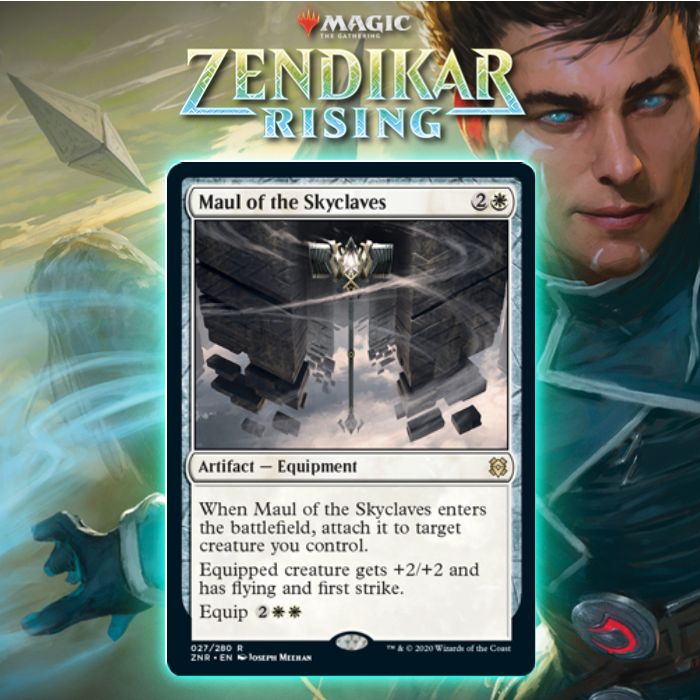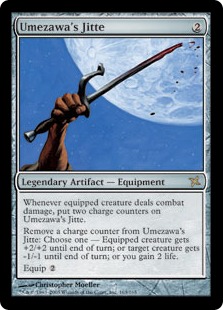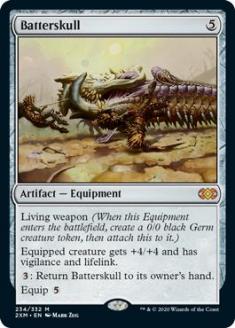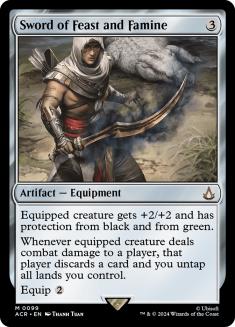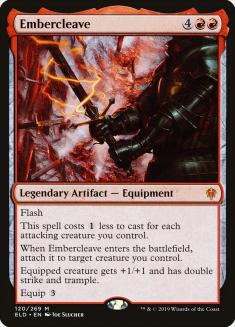It’s pretty common for Wizards of the Coast (WotC) to overshoot when they first design a new mechanic, learn from their mistakes, and then pull back a bit. With Equipment, we started with a powerful Sword cycle that was only kept from competitive play because of how broken Affinity was in the same block. Of course, that power was bolstered by two incredible pieces of Equipment, first the banned-in-multiple-formats Skullclamp and then the more focused but still powerful Cranial Plating. And right afterward came Umezawa’s Jitte.
Jitte was a multi-format all-star for many years and perhaps the single best rare or mythic in the history of Limited given its combination of raw power, rate, and versatility combined with the surprising dearth of answers to it that existed in Kamigawa block. Since then we haven’t seen many Equipment make their way into competitive play, and the notable exceptions, those that have seen play beyond being a role-player in a fringe archetype or two, exhibit a telling trend.
All of these cards get around the problem of Equipment having a high upfront investment and thus a lot of risk. That risk is supposed to be mitigated by the fact that the Equipment stays around if your opponent is able to interact with your creature, but you’re still losing a lot of tempo in most of those exchanges, since the Equipment likely costs significantly more to cast and equip than your opponent spent on their removal spell, plus the mana you invested in the creature itself.
But with Batterskull that creature costs zero, further reducing your risk. Sword increases the reward for connecting, making the risk more worthwhile, though it’s notable that it saw most of its competitive play alongside Stoneforge Mystic. And Embercleave has a much lower upfront cost since it equips for zero on the first go around while also being powerful enough to end the game in one or two attacks – a very high reward.
In the cases of Batterskull and Embercleave, they often didn’t function like Equipment at all. Batterskull is just another threat that is very difficult to interact with profitably, while Embercleave is the best Temur Battle Rage variant ever printed. That’s a far cry from the reusable Aura effect that we’ve come to associate with traditional Equipment.
It seems that WotC is moving away from that traditional design and toward something more powerful, since in Zendikar Rising we have a number of Equipment that effectively equip for free on the turn you cast them, so long as you have a creature to equip to.
Without an equip cost, these cards are going to function more like haste creatures in their own right, albeit creatures that are dependent on another to attack and block. You are still opening yourself up to removal, but not as badly since you won’t have invested as much mana, and you still get the benefit of it being an Equipment in a long game. This is especially important for decks with small creatures that get outclassed in long games, letting you attack when you otherwise wouldn’t. So while you open yourself up to removal, you make yourself significantly better against decks that are trying to play defense with their own creatures.
All of these variables serve to shift the balance of the risk-reward equation to be more positive for the Equipment. The last piece of the puzzle is to find one of these self-equipping Equipment that has a good enough rate for Constructed. Maul of the Skyclaves passes that test, and I expect it to be a staple during its time in Standard.
Looking at pure rate, Maul offers two points of power, two points of toughness, flying, and haste for your initial three-mana investment. That’s Skyknight Legionnaire with first strike. Not exactly a Constructed powerhouse, but it’s historically been quite good in Limited, and it’s honestly not far off from being playable in 60-card formats. And because Maul offers the benefits of Equipment, you don’t need to completely clear the bar on rate to merit consideration. Getting close is enough.
It’s also important that Maul provides evasion, since that makes it even more threatening to attach to your cheap creatures later in the game. It also means that your initial Skyknight Legionnaire will also provide flying to another of your creatures, making it excellent at pressuring planeswalkers.
Given that an Equipment theme is baked into this set, that seems like the most obvious place to start when finding a home for Maul of the Skyclaves:
Creatures (23)
- 4 Fervent Champion
- 4 Seasoned Hallowblade
- 4 Archpriest of Iona
- 4 Kor Blademaster
- 4 Akiri, Fearless Voyager
- 3 Fireblade Charger
Planeswalkers (2)
Lands (19)
Spells (16)

This deck has a sufficiently low curve to consistently have something to equip Maul to on Turn 3, which is step one. Step two is to have creatures that you actively want to equip. Fervent Champion and Fireblade Charger have the obvious synergy with Equipment, but to me the big star on this axis is Seasoned Hallowblade. Equipping onto a creature that dodges most removal is exceptional, since even if you don’t get to attack because you needed to activate Seasoned Hallowblade for protection, your position is left intact, which is much more important. These two cards will be best friends.
The last card that wants to pick up Equipment is Kor Blademaster, which is the card in the deck I’m least confident in despite the power of double strike. None of the Equipment in this deck provide a ton of power, and Kor Blademaster is a very weak card if your opponent is interacting early and often, so it’s often going to be most effective in games that you’re winning anyway – a huge red flag for me.
The other option for this slot is Kargan Intimidator, which pushes the Warrior theme while being a more powerful standalone card. Its ability to give your other creatures trample also plays well when you’re pumping them with Equipment. I’m going to start by erring toward the card that pushes the Equipment synergy as far as possible, but I wouldn’t be surprised if this swap happens rather quickly in testing.
This deck is going to use extra mana very easily because Equipment are natural mana sinks, so I’m happy to have an effective 25 here with the modal double-faced cards (DFCs). I could definitely see pushing that number even higher and playing some Emeria’s Calls but I’m wary of playing too many modal DFCs in a deck that wants to curve out. The mythic rare cycle will let you cast your spells on time, but paying six or nine life points to do so is a substantial cost.
With so many noncreature slots in the maindeck devoted to Equipment, the sideboard here has to have plenty of interaction. Fortunately, there are several good options for removal that also come with bodies to equip. Bonecrusher Giant is a proven staple, and Skyclave Apparition is among my picks for most powerful card in the set, and should exile several million copies of Uro, Titan of Nature’s Wrath over the next three months.
I like that this deck has powerful draws when it curves out, yet is more than capable of grinding out a long game, especially because it’s so good at using its mana and ensuring that its one-drops are relevant much longer than they typically are. My one qualm is that it doesn’t have any particularly large creatures to equip with Maul and go nuts. For that we’ll have to turn to green:
Creatures (27)
- 3 Scavenging Ooze
- 4 Lovestruck Beast
- 4 Questing Beast
- 4 Stonecoil Serpent
- 4 Bronzehide Lion
- 4 Swarm Shambler
- 4 Kazandu Mammoth
Lands (18)
Spells (15)

There are plenty of big creatures here to launch into the air, from classics like Lovestruck Beast and Questing Beast to newer standout Kazandu Mammoth. This deck is effectively modeled after Mono-Green Aggro with a small white splash that gives you Maul for excellent reach and Bronzehide Lion as an efficient two-drop, though I’m not sold that the Lion is better than Seasoned Hallowblade. It’s just so powerful to be able to protect your early creatures for zero mana so it doesn’t impede your ability to curve out.
That protection is even more important here because this list is trying to take advantage of The Great Henge. Maul pumping rather than providing a new body makes it easier to cast a cheap Henge on the early turns while also providing extra mana to move it around later on. Henge also plays excellently with Kazandu Mammoth, which in combination with Fabled Passage can get up to seven power on Turn 4, allowing you to cast Henge and recoup the two mana you spent immediately.
Think about this curve: Turn 3 Mammoth, Turn 4 Fabled Passage + The Great Henge + Questing Beast, attacking for twelve damage and drawing an extra card. You can also cast Henge on Turn 4 off just Mammoth and a land, or the curve of Bronzehide Lion into Maul. There are enough ways to cast it early that I’m maindecking three copies despite its clear diminishing returns.
The white splash also lets you maindeck Sejiri Shelter over Ranger’s Guile. This effect is powerful in certain spots, but often does nothing if you can’t afford to hold up the mana for it or draw it late when you need a threat. But stapling the effect onto a land raises the cards floor significantly.
Using Maul as a Role-Player
The last home I found for Maul is similar to the above list, but instead of playing naturally big creatures, it uses counter synergies to build them. These decks, because of their synergies, often struggle to attack through blockers, so the evasion on Maul is quite important as a way to close games in creature mirrors.
Creatures (28)
- 2 Scavenging Ooze
- 4 Stonecoil Serpent
- 3 Basri's Lieutenant
- 4 Conclave Mentor
- 3 Wildwood Scourge
- 4 Swarm Shambler
- 4 Luminarch Aspirant
- 4 Oran-Rief Ooze
Planeswalkers (2)
Lands (18)
Spells (12)

My co-host Corey Baumeister played Wildwood Scourge in a similar shell to this on VS Live! during Core Set 2021 preview season, and ever since I’ve been impressed by how quickly that card gets out of control in combination with Conclave Mentor. Both Swarm Shambler and Oran-Rief Ooze represent creatures that can immediately trigger the Scourge for little or no additional mana, leading to some very explosive draws.
You can go tall by making a big creature and then jumping it with Maul, but this deck can also go wide with Swarm Shambler, Basri’s Lieutenant, and Basri Ket leaving around 1/1s as your opponent interacts. Those bodies are often irrelevant, but Maul turns them into real threats. In this way Maul helps the deck play through removal as well as close the game through blockers. It’s not a core part of the deck, but it’s a key role-player that is perfectly playable by itself.
In fact, I’m encouraged by there only being space for two copies of the card in this list, because that means there are plenty of options to fill out the list. Synergy-driven decks are often pushing the boundaries of what’s playable with their last slots, especially just after rotation when the Standard card pool is at its smallest. But there are plenty of options here, to the point where I’m not even playing Basri’s Solidarity because it’s too weak when your synergies haven’t come together. Vastwood Fortification may not be nearly as powerful, but being a modal DFC makes it easy to get a bit of that effect in the deck, making Basri’s Solidarity less necessary.
I always love piloting aggro decks that play well into the late-game, and having mana sinks is a huge part of that. But the problem with Equipment being such a huge risk when your opponent wants to be casting removal on the early turns anyway is often too much to overcome. Maul having a much lower risk while also playing key roles in these aggro decks makes it much more appealing.
Yes, there will be games where your opponent’s Eliminate blows you out and leaves you far behind on the battlefield, but these decks are built to have plenty of options on Turn 3, so that you can effectively play around that from your opponent. Also, with Roil Eruption and Bloodchief’s Thirst entering the format as powerful sorcery-speed removal spells as well as modal DFCs forcing players to play off-curve, you’ll have more windows to just curve out without worry. Maul of the Skyclaves is so much more than just an Equipment, and you shouldn’t be treating it as one.

